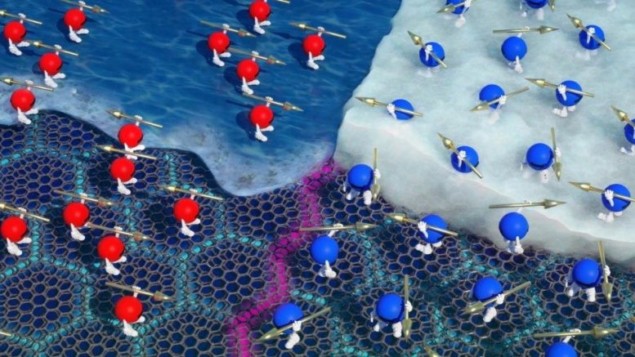
When most solids are heated, they melt into liquids. This behaviour makes sense in terms of entropy, or disorder: a liquid state is usually more disordered than a solid state, and higher temperatures mean that the particles within a material vibrate randomly with more energy. One exception, however, is helium-3. This isotope of helium solidifies on heating, because in its solid state, fluctuations in its atoms’ nuclear spin (or internal “rotation”) give it a higher entropy than its liquid counterpart. This phenomenon is known as the Pomeranchuk effect after the theoretical physicist Isaak Pomeranchuk, who predicted it in 1950.
Two independent teams of researchers – one led jointly by Shahal Ilani of Israel’s Weizmann Institute and Pablo Jarillo-Herrero of the Massachusetts Institute of Technology, US (MIT) and the other by Andrea Young of the University of California, Santa Barbara, US – have now unearthed an analogue to the Pomeranchuk effect for electrons in magic-angle twisted bilayer graphene (MATBG). These first measurements of electron entropy in MATBG revealed an unexpected phase transition in this two-dimensional carbon system, and could provide fresh insights into the physics of other strongly-correlated systems such as high-temperature superconductors.
Artificial “superlattice”
MATBG consists of two sheets of graphene (crystals of carbon atoms arranged in a one-atom-thick hexagonal lattice) stacked on top of each other with a small misalignment angle. This twisting arranges the atoms in a moiré pattern with a period that depends on the relative angle between the sheets’ crystallographic axes rather than the spacing between individual atoms.
The moiré pattern acts as an artificial “superlattice” in which the material’s unit cell (the simple repetition of carbon atoms in its crystal structure) hugely expands in all directions. This stretching dramatically affects the way electrons interact in the material. At the so-called “magic” angle of 1.1°, the energy bands of the electrons flatten out, causing the electrons to slow down almost to a halt. This dramatic reduction in velocity leads to correlated behaviour such as superconductivity, magnetism and other quantum phenomena.
In MATBG, the electrons come in four flavours: spin up, spin down, and two “valleys”. Each lattice site in the moiré pattern than thus hold up to four electrons. When all moiré sites are completely full — that is, when each site has four electrons – MATBG behaves as a simple insulator.
Deceptively simple system
At filling levels of around one electron per moiré site, most electron transport measurements to date have indicated that the system’s behaviour is likewise relatively straightforward: it acts like an ordinary metal, or Fermi liquid (with an electrical resistance that remains finite even in the limit of zero temperature). This superficially simple picture, however, turns out to hide a wealth of detail, since this is the filling at which the Weitzmann/MIT and UCSB teams noticed the Pomeranchuk effect in action.
The researchers, who report their work in two back-to-back Nature papers, have now found, counterintuitively, that the (Fermi) liquid phase transforms to a solid-like highly exotic correlated metal phase upon heating near a metal-like filling of one electron per moiré site in MATBG. In the liquid phase, the spatial positions of electrons are disordered, but their magnetic moments (arrows) are perfectly aligned. In the solid-like phase, the electrons are ordered in space but their magnetic moments fluctuate freely.
Like in solid helium-3
“The large entropy we see in the correlated metal phase is analogous to that observed in solid helium-3, but instead of atoms and nuclear spin, in MATBG we have electrons and electronic spins (or valley magnetic moments),” explains theoretical physicist Erez Berg of the Weizmann Institute, who collaborated with both teams. “The fact that the effect disappears when a strong magnetic field is applied to the material confirms that the effect is coming from the fluctuations of the electron magnetic moments.”
The researchers also found that that the entropy per electron of the high-temperature correlated metal phase was greater than that of the low-temperature Fermi liquid phase by a fraction of the Boltzmann constant, KB (where KB=1.38 x 10-23 J/K) per lattice site. In the UCSB experiments, the increase in entropy was 0.2 KB, while the Weizmann team found a value of 0.8 KB. This value is close to the entropy expected when the MATBG has one free electronic spin per moiré site.

‘Magic-angle’ graphene doubles up
Measuring the entropy of electrons in atomically-thin structures like graphene is no mean feat. This is because 2D materials contain very few electrons – unlike their bulk counterparts, which have them in abundance. Indeed, this is the first time researchers have succeeded in measuring the entropy of an atomically thin 2D system.
Biao Lian, a physicist at Princeton University in the US, notes that the new findings, while important, “leave many open questions”. In a related News and Views article, he notes that it is not yet known whether the low-temperature metal phase is separated from the high-temperature phase by a first-order phase transition (characterized by an abrupt change in thermodynamic properties) or a smoother “crossover” transition.
Another mystery is the absence of the electronic Pomeranchuk effect at other integer fillings of the band structure of MATBG (that is, when the bands are half or three-quarters full). Similar behaviour, Lian argues, could occur at these fillings, but it has not yet been observed.



